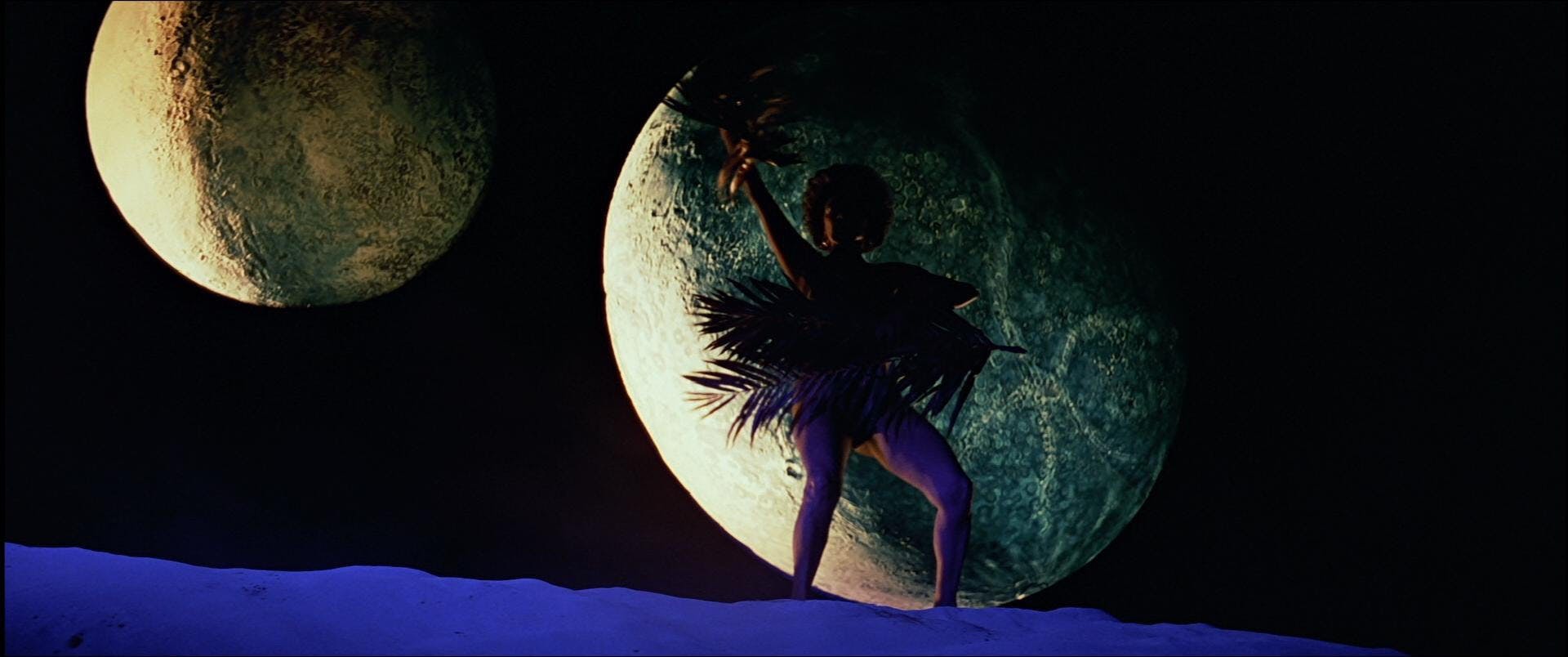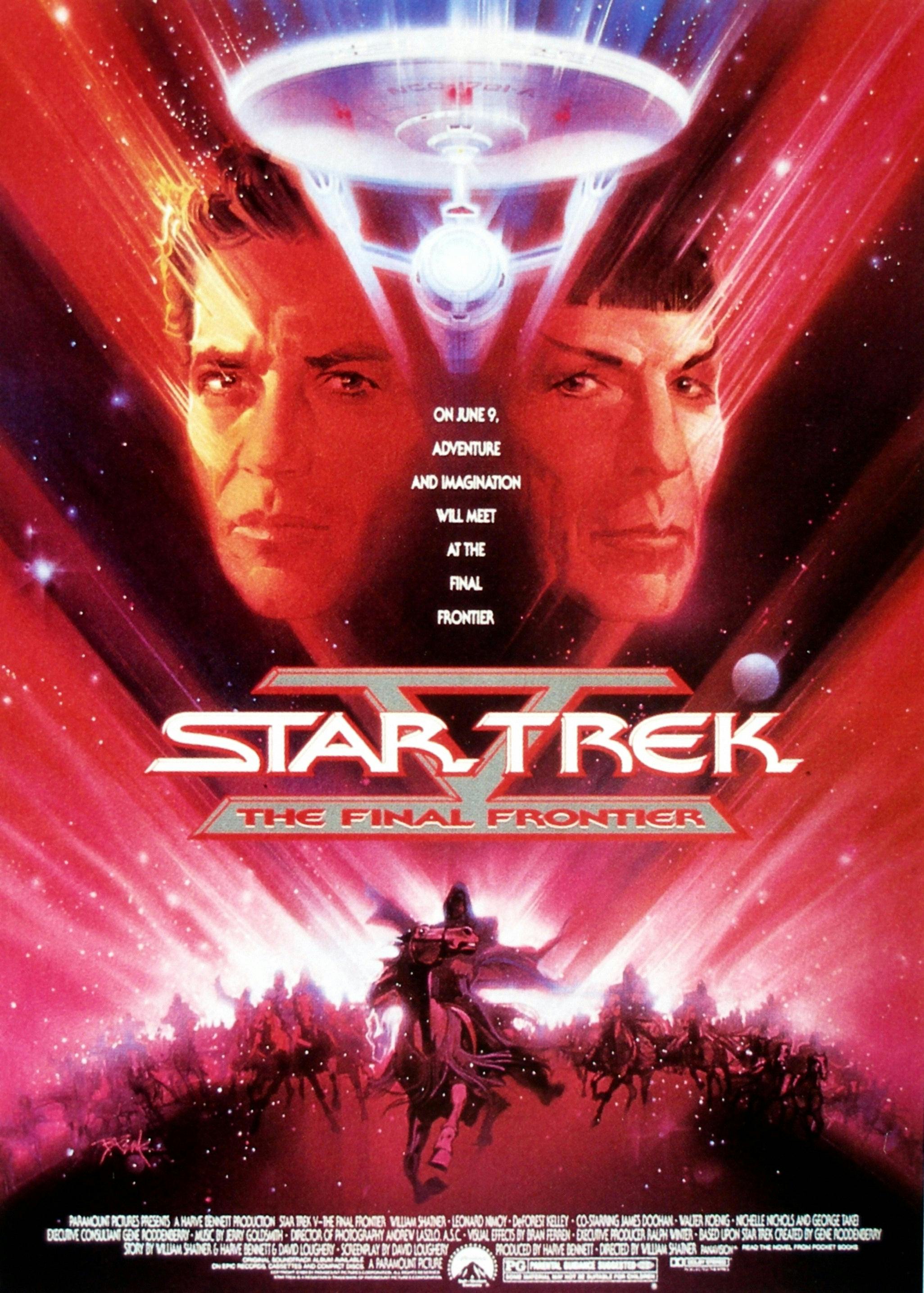Published Jul 27, 2020
The Story Behind Star Trek V: The Final Frontier's Musical Moment
Dan Kuramoto of the band Hiroshima explains how he got involved with Uhura's big number.

StarTrek.com | Getty Images - MICHAEL TRAN / Contributor
There’s a bizarre moment midway through Star Trek V: The Final Frontier, the William Shatner-helmed feature film enjoyed as much ironically as sincerely by Trekkies since its release in 1989. During a mission to rescue a trio of diplomats from the zealot Sybok, Captain James T. Kirk and company need a way to divert a group of armed revolutionaries so that our heroes can steal their horses and ride into combat. This diversion takes the form of Commander Uhura performing a live, nude cabaret act on a hilltop.
This scene tends to provoke a lot of questions from viewers. “Is that really Nichelle Nichols dancing dressed in nothing but two decorative fans and convenient lighting?” Yes, it is. “Is that her singing voice?” No, it isn’t, though she was promised it would be. And, finally, “What’s that song she’s singing?”
The voice belongs to Machun, then-vocalist for the band Hiroshima, and the song is “The Moon’s a Window to Heaven,” arranged and performed by Hiroshima both here and in the full-band version that features at the end of the film’s original soundtrack album. “The Moon’s a Window to Heaven” is one of only a handful of original songs ever written for Star Trek, a series that typically sticks to orchestral scores and time-tested catalog music. It’s first heard as the instrumental tune playing in the dive bar in Paradise City, where Romulan diplomat Caithlin Dar meets her Human and Klingon counterparts, days before being highlighted by Uhura’s live rendition. Its recurrence implies that the song is either a recent hit or a popular standard in the Federation, a rare glimpse into the state of pop music in the 23rd century.

StarTrek.com
The song is credited to legendary composer Jerry Goldsmith and lyricist John Bettis, but belongs just as much to Dan Kuramoto, composer, arranger, multi-instrumentalist, and bandleader for Hiroshima. Formed in 1974 in Los Angeles by Dan Kuramoto, June Kuramoto and Danny Yamamoto, Hiroshima has long represented the core Star Trek principle of Infinite Diversity in Infinite Combinations, augmenting the typical mid-century pop instrumentation of guitar, bass, keyboard, and drum kit with Japanese instruments like koto, shakuhachi, and taiko to create a unique and inimitable sound. Hiroshima has toured the world and sold over four million records, making a brief detour into the Star Trek universe along the way.
StarTrek.com recently interviewed Dan Kuramoto about the experience of creating this unique piece of deep Star Trek lore.
StarTrek.com: For readers unfamiliar with Hiroshima, how would you define your genre of music? You’ve been described as smooth jazz, jazz/rock fusion, you’ve got a Grammy nomination in the R&B Instrumental category, but when a stranger asks you what kind of music you play, what do you tell them?
Dan Kuramoto: We like to think we play American music, which is non-categorical/diverse/inclusive/evolving. Most of us grew up in minority communities that were very multicultural. Since most of the band is Japanese-American we are heavily influenced by Japanese music and musical instruments. In fact our ’star’ is June Kuramoto. She was born in Japan, came to the US at [age] 6 and is widely considered the greatest koto player in the world. She was raised in an African-American community in Los Angeles, so along with her lifetime of classical training she was also deeply influenced by R&B, Soul and Jazz. Our second Grammy nomination was in the contemporary jazz category, so even the Grammys see us in various styles.
By 1989, Hiroshima had a gold record and a Grammy nomination under their belts. How did you become involved in Star Trek V?
DK: I honestly think Star Trek was looking for a music that was truly different—but relatable. I think because we are so different stylistically, but popular enough to have sold millions of records, [that] made us interesting. I had no idea that we would get to work with the brilliant Jerry Goldsmith, who was an amazing mentor. He liked our blending of cultures in our music.
What was your level of familiarity with Star Trek before working on the film?
DK: We were huge fans of the TV series, and George Takei was a big supporter of our band. And we saw all the movies. Our friends — the jazz group, Yellowjackets — had done some music in the film that preceded ours.
What was the state of “The Moon’s a Window to Heaven” when you first heard it? Was it just words and music on a page, were there demos? I’d love to know how the arrangement came together.
DK: We had a song title. We were told we’d do a song and some music cues. It all came together pretty quickly… I really don’t recall at this point when we got the final melody and lyrics. John [Bettis] did the lyrics and we worked together on the rest. John is a total pro. Just chilled with his pipe, he really understood working with the studios and made life easy. And very talented.
What was your personal impression of Jerry Goldsmith?
DK: Man, Jerry was a very heavy cat! I was very familiar with his scores—he was one of the true pioneers of combining the orchestra with electronics and synthesizer and creating new sounds. A genius who really “cracked the whip.” Made us understand that you had to work fast and be adaptable. Gave me so much good advice!
You’re a very prolific composer, credited with the bulk of the Hiroshima catalog. Was working within the framework of someone else’s words and melody more freeing, or more confining?
DK: Actually I was surprised they gave me almost total freedom. They let me cut the rhythm tracks on my own at the studio of my choice. Later we finished up on the lot and Bill Shatner — who directed — just sort of hung out with us! At one point he took off his Star Trek pin and pinned it on my jacket. I still have it.
Did you receive any specific notes or direction from William Shatner about what he wanted out of the track, or the purpose he wanted it to serve for the film?
DK: Bill was pretty new to directing and he pretty much left the music up to us and Jerry.
“The Moon’s a Window to Heaven” is, theoretically, a pop song from the distant future. Was there any effort to try and be predictive or conjectural about what a Top 10 hit from 2287 might sound like?
DK: Ha! No. We were trying to just make the scene work.

StarTrek.com
What was your first reaction when you heard the song in the context of the film? It is a, uh, well, it’s a talked-about moment.
DK: Well, we were very honored to be a part of a Star Trek film. I recall at the time we were on tour playing Wolf Trap in Tyson’s Corner, Virginia and we saw the movie.
Did being featured on a Star Trek film soundtrack have an effect on widening your audience?
DK: Not noticeably, but we haven’t featured “The Moon’s a Window to Heaven” in a Hiroshima live set yet.
Hiroshima continues to tour the United States and is currently working on a new album expected to be released in Fall 2020. For more information about the band, visit hiroshimamusic.com.
This interview has been edited and condensed.
Dylan Roth (he/him) is a freelance pop culture writer and one quarter of the NY-based rock band The Hell Yeah Babies. You can follow him on Twitter @DylanRoth.

